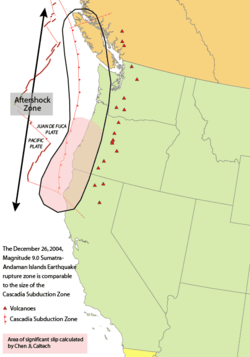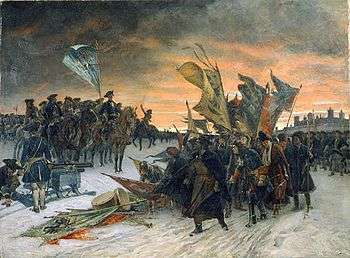1700
| Millennium: | 2nd millennium |
|---|---|
| Centuries: | 16th century · 17th century · 18th century |
| Decades: | 1670s · 1680s · 1690s · 1700s · 1710s · 1720s · 1730s |
| Years: | 1697 · 1698 · 1699 · 1700 · 1701 · 1702 · 1703 |
| 1700 by topic: | |
| Arts and Science | |
| Architecture - Art - Literature - Music - Science | |
| Lists of leaders | |
| Colonial governors - State leaders | |
| Birth and death categories | |
| Births - Deaths | |
| Establishments and disestablishments categories | |
| Establishments - Disestablishments | |
| Works category | |
| Works | |
| Gregorian calendar | 1700 MDCC |
| Ab urbe condita | 2453 |
| Armenian calendar | 1149 ԹՎ ՌՃԽԹ |
| Assyrian calendar | 6450 |
| Bengali calendar | 1107 |
| Berber calendar | 2650 |
| English Regnal year | 12 Will. 3 – 13 Will. 3 |
| Buddhist calendar | 2244 |
| Burmese calendar | 1062 |
| Byzantine calendar | 7208–7209 |
| Chinese calendar | 己卯年 (Earth Rabbit) 4396 or 4336 — to — 庚辰年 (Metal Dragon) 4397 or 4337 |
| Coptic calendar | 1416–1417 |
| Discordian calendar | 2866 |
| Ethiopian calendar | 1692–1693 |
| Hebrew calendar | 5460–5461 |
| Hindu calendars | |
| - Vikram Samvat | 1756–1757 |
| - Shaka Samvat | 1621–1622 |
| - Kali Yuga | 4800–4801 |
| Holocene calendar | 11700 |
| Igbo calendar | 700–701 |
| Iranian calendar | 1078–1079 |
| Islamic calendar | 1111–1112 |
| Japanese calendar | Genroku 13 (元禄13年) |
| Javanese calendar | 1623–1624 |
| Julian calendar | Gregorian minus 10 or 11 days |
| Korean calendar | 4033 |
| Minguo calendar | 212 before ROC 民前212年 |
| Nanakshahi calendar | 232 |
| Thai solar calendar | 2242–2243 |
| Wikimedia Commons has media related to 1700. |
1700 (MDCC) was an exceptional common year starting on Friday (dominical letter C) of the Gregorian calendar and a leap year starting on Monday (dominical letter GF) of the Julian calendar, the 1700th year of the Common Era (CE) and Anno Domini (AD) designations, the 700th year of the 2nd millennium, the 100th and last year of the 17th century, and the 1st year of the 1700s decade. As of the start of 1700, the Gregorian calendar was 10 days ahead of the Julian calendar, which remained in localized use until 1918. As of March 1 (O.S. February 19), when the Julian calendar acknowledged a leap day and the Gregorian calendar did not, the Julian calendar fell one day further behind, bringing the difference to 11 days.
In Sweden, the year started in the Julian calendar and remained so until February 28. Then, by skipping the leap day, the Swedish calendar was introduced, letting February 28 be followed by March 1, giving the entire year the same pattern as a common year starting on Monday. This calendar, being 10 days behind the Gregorian and 1 day ahead of the Julian, lasts until 1712.
Events
January–June
- January 1 – Protestant Western Europe, except England, starts using the Gregorian calendar
- January 1 (Julian) – Tsardom of Russia begins numbering its calendar from the birth of Christ (Anno Domini) instead of since the Creation (Anno Mundi).
- January 26 – At approximately 9 p.m., the Cascadia earthquake occurred with an estimated moment magnitude of 8.7–9.2. This megathrust earthquake ruptured about 1,000 kilometers (620 miles) of the Cascadia Subduction Zone and caused a tsunami that struck the coast of Japan approximately 10 hours later.
- February 3 – The 'Lesser Great Fire' destroys a substantial part of central Edinburgh, Scotland.[1]
- February 12 – The Great Northern War begins with a joint invasion of Swedish territory in Germany and Latvia by Denmark and Poland/Saxony. Sweden has control of the Baltic Sea and holds territory that includes Finland, Estonia, Latvia and parts of northern Germany. To challenge its power, an alliance is formed between Tsar Peter I of Russia, King Frederick IV of Denmark and Augustus II the Strong, King of Poland and Elector of Saxony. Sweden's ruler is the militaristic Charles XII, known as the "Swedish Meteor".
- February 27 – Island of New Britain discovered by William Dampier in the western Pacific.[2]
- March 1 (Gregorian) – Protestant Germany and Denmark–Norway adopt the Gregorian calendar.
- March 1 (Swedish), March 11 (Gregorian), February 29 (Julian) – Swedish calendar adopted.
- early March – William Congreve's comedy The Way of the World is first performed in London.[3][4]
- March 25 – Treaty of London signed between France, England and Holland.[5]
- April – Fire destroys many buildings in Gondar, the capital of Ethiopia, including two in the palace complex.
- May – In Rhode Island (American colony), Walter Clarke, three term former Governor of Colony of Rhode Island and Providence Plantations, is elected deputy governor for the second time, serving under is brother-in-law Samuel Cranston.
- May 5
- Within a few days of John Dryden's death (May 1 O.S.), his last written work (The Secular Masque) is performed as part of Vanbrugh's version of The Pilgrim.
- William Penn begins monthly meetings for blacks advocating emancipation.
July–December
- July 11 – The Prussian Academy of Sciences is founded with Gottfried Leibniz as president.[6]
- Summer – Charles XII of Sweden counter-attacks his enemies by invading Zealand (Denmark), assisted by an Anglo-Dutch naval squadron under Sir George Rooke, rapidly compelling the Danes to submit to peace.
- August 18 (August 7 O.S.) – Peace of Travendal concluded between the Swedish Empire, Denmark–Norway and Holstein-Gottorp in Traventhal. On the same day, Augustus II, King of Poland, and Peter the Great, Tsar of Russia, enter the war against Sweden.
- Late summer – A Russian army invades Swedish Estonia and besieges the town of Narva.
- November 1 – Charles II, last Spanish king of the House of Habsburg, dies insane at the Royal Alcazar of Madrid (aged 38) leaving no children.
- November 15 – Louis XIV accepts the Spanish crown on behalf of his grandson Philip of Anjou, who becomes Philip V of Spain (to 1746), thus triggering the War of the Spanish Succession (1701–1741).
- November 18 – Battle of Olkieniki, Lithuanian Civil War: victory for the anti-Sapieha coalition.
- November 23 – Pope Clement XI succeeds Pope Innocent XII as the 243rd pope.
- November 30 (November 19 O.S.; November 20 Swedish calendar) – Battle of Narva in Estonia. Having led his army of 8,000 on a forced march from Denmark to Estonia, Charles XII of Sweden routs the huge Russian army at Narva.
- December 28 – Laurence Hyde, 1st Earl of Rochester, is appointed Lord Lieutenant of Ireland.

Date unknown
- Mission San Xavier del Bac is founded in New Spain near Tucson, as a Spanish Roman Catholic mission.
- An inventory made for the Medici family of Florence is the first documentary evidence for a piano, invented by their instrument keeper Bartolomeo Cristofori.
- An English translation of the novel Don Quixote, "translated from the original by many hands and published by Peter Motteux", begins publication in London. While popular among readers, it will eventually come to be known as one of the worst translations of the novel, totally betraying the spirit of Miguel de Cervantes's masterpiece.
- The value of sales of English manufactured products to the Atlantic economy is £3.9 million.
- approx. date – Lions become extinct in Libya.
Ongoing
- Nam tiến: southward expansion of the territory of Vietnam to cover the entire Indochina Peninsula.[7]
Births
- January 29 – Konstancja Czartoryska, Polish noblewoman (d. 1759)
- February 2 – Johann Christoph Gottsched, German writer (d. 1766)
- February 8 – Daniel Bernoulli, Dutch-born Swiss mathematician (d. 1782)
- March 13 – Michel Blavet, French flutist (d. 1768)
- April 30 – Charles Frederick, Duke of Holstein-Gottorp, Swedish nobleman (d. 1739)
- May 7 – Gerard van Swieten, Dutch-born physician (d. 1772)
- May 12 – Luigi Vanvitelli, Italian architect (d. 1773)
- May 19 – José de Escandón, Spanish colonial governor (d. 1770)
- May 26 – Nicolaus Ludwig Zinzendorf, German religious and social reformer (d. 1760)
- August 13 – Heinrich, count von Brühl, German statesman (d. 1763)
- August 17 – Clemens August of Bavaria, Archbishop-Elector of Cologne (d. 1761)
- September 11 – James Thomson, Scottish poet (d. 1748)
- September 30 – Stanisław Konarski, Polish writer (d. 1773)
- October 10 – Lambert-Sigisbert Adam, French sculptor (d. 1759)
- November 19 – Jean-Antoine Nollet, French abbot and physicist (d. 1770)
- November 28 – Nathaniel Bliss, English astronomer (d. 1764)
- December 25 – Leopold II, Prince of Anhalt-Dessau, Prussian general (d. 1751)
- date unknown
- Franciszek Salezy Potocki, Polish nobleman (d. 1772)
- Ivan Ranger, Austrian painter (d. 1753)
Deaths
- January 7 – Raffaello Fabretti, Italian antiquary (b. 1618)
- January 21 – Henry Somerset, 1st Duke of Beaufort, English politician (b. 1629)
- January 22 – Jacob Balthasar Schutz, composer (b. 1660)
- February 12 – Aleksei Shein, Russian commander and statesman (b. 1662)
- March 14 – Henry Killigrew, English dramatist (b. 1613)
- May – Louis Jolliet, Canadian explorer (b. 1645)
- May 5 – Angelo Italia, Sicilian architect (b. 1628)
- May 12 – John Dryden, English poet and dramatist who was poet laureate (1670–1688). His works included the poem Annus Mirabilis (1667) and the tragedy All For Love (1678) (b. 1631)
- May 15 – John Hale, American witch hunter (b. 1636)
- May 23 – Jens Juel, Danish diplomat (b. 1631)
- July
- Thomas Creech, English translator, suicide (b. 1659)
- John Lowther, 1st Viscount Lonsdale, English politician (b. 1655)
- July 30 – Prince William, Duke of Gloucester, member of the English royal family (b. 1689)
- September 15 – André Le Nôtre, French landscape gardener (b. 1613)
- September 27 – Pope Innocent XII (b. 1615)
- October 16 – Patriarch Adrian of Moscow, Russian Orthodox Church leader (b. 1627)
- November 1 – Charles II of Spain (b. 1661)
- November 25 – Stephanus Van Cortlandt, first native born mayor of New York (b. 1643)
- date unknown
- Caius Gabriel Cibber, Danish sculptor working in England (b. 1630)
- Kamalakara, Indian astronomer and mathematician (b. 1616)
- Louis Guittar, French pirate, hanged
References
- ↑ Colville, Ian (2011-02-08). "The Lesser Great Fire of 1700 in Edinburgh". On this day in Scotland. Retrieved 2011-11-21.
- ↑ Penguin Pocket On This Day. Penguin Reference Library. 2006. ISBN 0-14-102715-0.
- ↑ Williams, Hywel (2005). Cassell's Chronology of World History. London: Weidenfeld & Nicolson. p. 289. ISBN 0-304-35730-8.
- ↑ Hochman, Stanley. McGraw-Hill Encyclopedia of World Drama. 4. p. 542.
- ↑ "The House Laws of the German Habsburgs". Retrieved 2011-11-21.
- ↑ O'Connor, John J.; Robertson, Edmund F. (August 2004). "Berlin Academy of Science". MacTutor History of Mathematics. Retrieved 21 November 2011.
- ↑ Nguyen The Anh (1989). "Le Nam tien dans les textes Vietnamiens". In Lafont, P. B. (ed). Les frontieres du Vietnam. Paris: Edition l’Harmattan.


